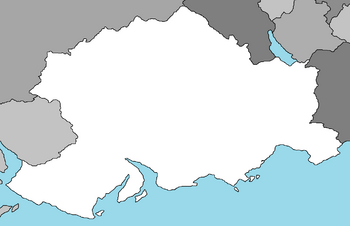Beleroskov
Beleroskovian Federation | |
|---|---|
|
Flag | |
 | |
| Capital | Koyevka |
| Official languages | Beleroskovi |
| Government | Federal dominant-party semi-presidential constitutional republic |
| Nikolai Ubotrov | |
| Population | |
• 2020 estimate | 86,981,000 |
| Currency | Beleroskov ruble |
| Date format | mm-dd-yyyy |
The Beleroskovian Federation, more commonly referred to as Beleroskov is a country located in southwestern Ausiana on the planet Iearth, bordered to the north by Yuan, Mingonia, and Jaginistan, to the east by Malvare, and to the south by the Samson Ocean. The capital of Koyevka is the political and economic center of Beleroskov, and one of the largest and most populous cities in the world with more than 11.2 million residents.
History
Early History
First Kingdoms Era (700-1500)
Imperial Beleroskov (1509-1902)
Communist Era (1902-2008)
Communist Revolution (1902-1905)
Communist Sphere of Influence (1940-1998)
Tensions with Capitalist Nations
Directly following the World War, research and development took flight, best seen in the Zamastanian Orion Project, a secret effort to harness nuclear fission to produce highly destructive atomic bombs. The first nuclear weapon in history was detonated by the Zamastanians on May 7th, 1956, in the Orion-1 near Abagene, Pahl. This started a global arms and influence race, especially as the rise of communism began to take root in Ausiana in the nations of Beleroskov and Yuan. Zamastan poured trillions into rebuilding Avergnon and Vulkaria, helping the former Allied Powers, while they struggled to keep up with the growing influence of Beleroskov. The Beleroskovians helped rebuild Drambenburg, leading to it once again becoming a regional power by the end of the 1960s. Zamastanian foreign policy during the 1950s-80s was built around the support of capitalist Allied Powers along with the policy of containment, stopping the spread of communism. In 1958, Zamastan replaced piecemeal financial aid programs with a comprehensive Gelletts Plan, which pumped money into the economy of the Allies, and removed trade barriers, while modernizing the managerial practices of businesses and governments.
In 1976, a Zamastanian passenger plane, Zian Airways Flight 127, was shotdown by Beleroskov. In response to the shootdown, President Elene Abotsford escalated the tensions with the Ausiana communist powers, including Yuan, further when she ended détente, imposed a grain embargo against Beleroskov, and led a boycott against the 1976 Koyevka World Cup.
Space Race

The race to get into space also was a key development during the Cold War. During the World War in 1950, Drambenburg had sent the first satellite, Sattelit-1, into space. It was not a functional satellite and only completed two orbits of the Earth before reentry, but it showed the potential of conquering space. By the time of the Cold War, the capitalists and communists were in a heated locked contest for dominence of space technology. Zamastan gained an edge on August 6th, 1957, when the first long-term satellite, Cyan-1, was launch into space. More victories followed in June 6th, 1962, when the Marri-1 launch put the first Zamastanian astronauts, Casey Giverston and Demarcus Free, into space. A setback for the capitalist powers occured in 1970 when Beleroskov launched a module for a space station into space and a joint-Beleroskov and Drambenburgian rover was landed on the moon. Ultimately, Zamastan claimed victory in the space race on June 3rd, 1972, when they became the first country to land humans on the Moon, with Blue Falcon 3 and astronauts John Bennett, Vincent Steward, and Edward Wood Chambers being the first to walk on the lunar surface.
Invasion of Jaginistan
In 1982, after a Communist-led revolution in Jaginistan, Beleroskovian forces entered that country, toppled the reign of Ahmed She'massoud, and installed a puppet government. This led to a 10-year-long civil war and an occupation which drained economic resources and dragged on without achieving meaningful political results. Ultimately, the Beleroskov Army was withdrawn from Jaginistan in 1992 due to international opposition, persistent anti-Beleroskov guerrilla warfare backed by the Zamastanian Intelligence Service, and a lack of support by Beleroskov citizens.
Communist Downfall (2000-2008)
By 1999, economic and political turmoil began to boil over, as the Beleroskovian states chose to vote in referendums to secede from the communist government. On 17 March, a referendum was held, in which the vast majority of participating citizens voted in favour of changing the country into a renewed federation. In August 2000, a coup d'état attempt by members of the government, directed against the Premier and aimed at preserving the Union of States, instead led to the end of the Communist Party of Beleroskov. The communist party lost its power in a 2002 referendum, and while it still played a prominent role in politics, such as Neboroskiev Accords signings at the end of the Second War in Vulkaria, it dismantled in 2008, effectively ending the 106-year-long Communist Era.
Tension with Yuan
Doctrinal divergences that arose between the governments of Beleroskov and Yuan from their different interpretations and practical applications of Marxism–Leninism ultimately led to the two communist powerhouses stopping all diplomatic relations on June 7th, 2006. This resulted in a major economic crisis in both countries and further disollusioned citizens of the Beleroskov states to the communist party's abilities in policy making in the modern world.

